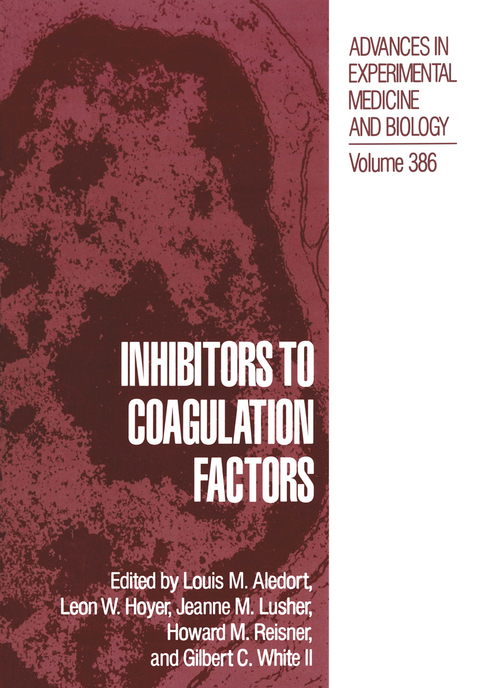
Inhibitors to Coagulation Factors
Springer-Verlag New York Inc.
978-1-4613-8001-6 (ISBN)
"For the blood is the life . . . . "(Deut. 12 :23) " . . . because the blood, in its value as life, makes atonement" (Lev. 17: 11) HemoPhilia is a rare disease, severe hemophilia rarer still, yet the written history of hemophilia extends back over a millennium and a half. In the ancient Middle East, blood and life were coupled. Blood was the primary substance necessary for life, given to God in sacrifice and forbidden as a food to mortals by Levitical law. Blood was essential for rites of purification and consecration. But the flow of blood during menstruation or parturition rendered a woman unclean. The circumcision of a male child required 33 days of "blood purification" by the mother. ' Circumcision, the visible reminder of the covenant of Abraham lijith Yahweh, was required of newborn Jewish males. It "connote(d) suitability for participation in what God is doing. "2 Hence, free and uncontrolled bleeding of the male child during circumcision, during the ratification of God's covenant, would be noted with awe and concern by those of the Jewish faith. It should not be surprising that the first genetic counseling offered to families with hemophilia is found in the Babylonian Talmud (compilation of Jewish law dated to about the third century AD) and concerns the necessity for circumcision in families with what we would now call hemophilia.
I: Factors VIII, IX and von Willebrand factor, their molecular and antigenic structure: An overview.- Structure and function of factor VIII.- Molecular etiology of factor VIII deficiency in hemophilia A.- The incidence of factor VIII inhibitors in patients with severe hemophilia A.- Epitope specificity and functional characterization, of factor VIII inhibitors.- Immunogenetics of the human immune response to factor VIII.- Factor IX: Molecular structure, epitopes, and mutations associated with inhibitor formation.- Antibodies to von Willebrand factor in von Willebrand disease.- II. The molecular basis of the human immune response.- B-cell epitopes: Fact and fiction.- Antigen analogs as therapeutic agents.- III: Genetic variation and the immune response.- T-cell receptors in immune responses.- Immunoglobulin heavy chain variable region gene usage in human autoimmune diseases.- IV: Treatment of inhibitors.- Porcine factor VIII therapy in patients with factor VIII inhibitors.- Clinical presentation and management of patients with circulating anticoagulants.- The function of factor VIIa in hemophilia A: An hypothesis.- Clinical update on the use of recombinant factor VII.- Apheresis.- IVIg in the treatment of patients with factor VIII inhibitors.- V: Tolerance to coagulation factors.- Tolerance and intolerance to factor VIII: A clinical perspective.- Immune tolerance to Factor VIII: The international registry data.- Multiple mechanisms of immunologic tolerance: Novel approaches for unresponsiveness.- VI: New approaches to the inhibitor problem.- Variable (V) region-mediated control of autoreactivity to factor VIII.- Hepatic gene therapy for hemophilia B.- Panel discussion on the development of inhibitors: Who and why?.- Panel discussion on the development of inhibitors: Today and tomorrow?.- Poster Session Abstract.
| Reihe/Serie | Advances in Experimental Medicine and Biology ; 386 |
|---|---|
| Zusatzinfo | 324 p. |
| Verlagsort | New York, NY |
| Sprache | englisch |
| Maße | 170 x 244 mm |
| Themenwelt | Sachbuch/Ratgeber ► Natur / Technik ► Garten |
| Medizin / Pharmazie ► Medizinische Fachgebiete ► Pharmakologie / Pharmakotherapie | |
| Studium ► 2. Studienabschnitt (Klinik) ► Humangenetik | |
| Studium ► Querschnittsbereiche ► Infektiologie / Immunologie | |
| Naturwissenschaften ► Biologie ► Botanik | |
| Naturwissenschaften ► Biologie ► Zoologie | |
| ISBN-10 | 1-4613-8001-4 / 1461380014 |
| ISBN-13 | 978-1-4613-8001-6 / 9781461380016 |
| Zustand | Neuware |
| Haben Sie eine Frage zum Produkt? |
aus dem Bereich


